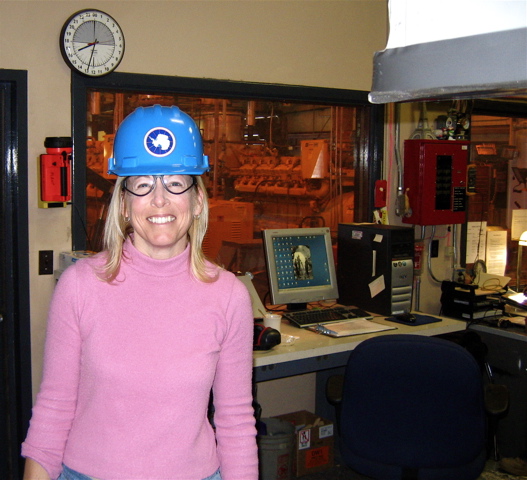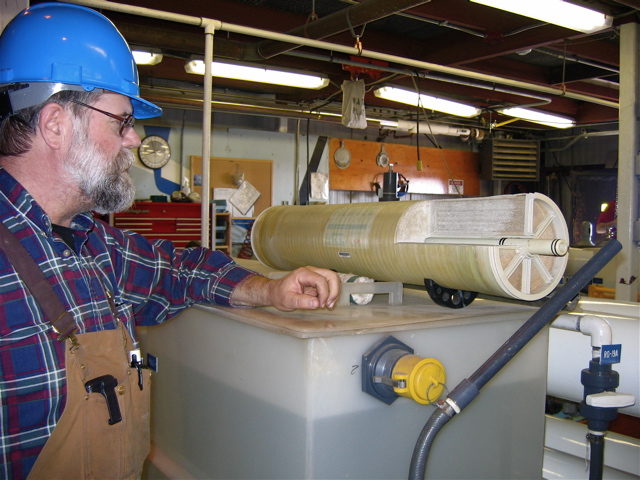( Log In ) Log In is for TREC Teachers & Researchers only
| Dena_Rosenberger |
 Dec 15 2005, 10:12 AM Dec 15 2005, 10:12 AM
Post
#1
|
 TREC Teacher    Group: TREC Team Posts: 96 Joined: 1-November 05 Member No.: 22 |
Power and Water
15 December, 2005 For those interested in things Antarctic, check out the weekly Antarctic newspaper at http://AntarcticSun.usap.gov Hello from the Ice! For additional Antarctic pics, check out the Gallery. Where’s Rosenberger? Power and Water Plants, McMurdo Station, Ross Island, Antarctica Jordan Dickens has been running the power plant in McMurdo for a long time. In fact, he not only runs the power plant, but also runs the water plant, and the new wastewater treatment plant, as well (and makes darn good popcorn!). And he knows them all inside and out. It takes a lot of work to provide power and water for over 1000 people in an isolated situation where ALL waste is considered hazardous and ALL waste must be shipped back to the United States. The "town" of McMurdo could not exist without relying on power to keep pipes from freezing and electricity for heating, cooking, and powering equipment. If the engines stopped, McMurdo would not have the electrical power to sustain livable conditions on this icy continent. Jordan first came to Antarctica in 1986 with a vast amount of experience working with engines in the U.S., as well as in the oil fields of South America and Morocco. Not only has he visited 68 countries and seven continents, but he has also been fortunate to work at all three U.S. research stations in Antarctica. He was the operation manager for one year at the Palmer Research Station on the Antarctic peninsula. He worked two years at the South Pole as the power plant mechanic and station electrician. He has wintered six times and summered twelve times on the "ice." Jordan Dickens explains the system:  POWER In the Power Plant, there are six engines on the main floor. Three are operating at any given time and the others are on standby in case of emergency and during routine maintenance. Each of the six huge engines has logged about 107,000 hours (If a car were driven at 65 mph for this many hours, it would have traveled almost 7 million miles…which is more than 14 round trips to the moon). In the event of an equipment failure, a standby engine can be online in minutes while power is directed to essential buildings (like Crary Lab and some public places). There are also eight emergency generators around the station. The “waste” heat from these engines is used to warm the dorms and the Galley building. Ready for my tour. Note the safety goggles!  Two of the six engines that drive McMurdo:  The engine control room houses operating and control panels, switchgear, and six feeders:  WATER So far this summer, the water use here at McMurdo has been calculated at 240-250 Liters of water per person per day. This figure includes drinking water, showers, food prep and clean-up, toilets, and labwork. All of the water used here comes from the ocean and is put through a process called Reverse Osmosis (RO). This process removes salt and other particles from the water, making it suitable to drink. First, the water must go through several types of filters to remove debris. Then, the water passes through a much finer set of filters made of polypropylene coils which block everything larger than 5 microns, or 10 times smaller than a human hair. A cutaway of the 5 micron filter:  This particle-free water is still salty at this point and now enters the RO part of the process. The pressure is raised from 45 psi (pounds per square inch) up to 850 psi (wow!) and the water is forced through 24 membranes at a rate of 80 gallons per minute. These RO units remove the salts:  Out of that 80 gallons, 28 gallons of fresh water are recovered and the remaining brine goes back out to the ocean. McMurdo uses about 80,000 gallons of fresh water per day. Fresh water is produced 24-7 and one huge tank is always on reserve in case of fire. Tests performed during the water processing include pH, alkalinity, Total Dissolved Solids (TDS), calcium (hardness), conductivity, and coliform bacteria. Did you know? The first and only book ever “published” in Antarctica is Ernest Shackelton’s Aurora Australis, hand-printed in 1908-09 by four of his men at Cape Royds on Ross Island (at Pony Lake!). The 80 copies were bound with a leather spine and covered with boards taken from crates. Only one or two copies come up for sale each decade and in 1999 one was sold for $55,000. (Lonely Planet – Antarctica) Current Conditions at McMurdo Station Improving conditions as a drier, off-continent air mass flows south into the area. (Maybe planes and helicopters will actually be able to take off and land) Right now: Winds from the east at 9 knots Pressure: 29.420 inHg Temperature: 30 oF/-1 oC with wind chill: 16 F/ -9 C Sunset: February 20 at 1:38 am |
Posts in this topic
 Dena_Rosenberger Power and Water Dec 15 2005, 10:12 AM
Dena_Rosenberger Power and Water Dec 15 2005, 10:12 AM
 Guest My god, Deeann, what an ugly dude that supervisor ... Mar 2 2006, 12:11 AM
Guest My god, Deeann, what an ugly dude that supervisor ... Mar 2 2006, 12:11 AM
 Peter And Antarctica won't be the same without Jorda... Apr 12 2006, 09:43 PM
Peter And Antarctica won't be the same without Jorda... Apr 12 2006, 09:43 PM  |
1 User(s) are reading this topic (1 Guests and 0 Anonymous Users)
0 Members:

|
NSF Acknowledgment & Disclaimer | Time is now: 30th October 2024 - 11:19 PM |
Invision Power Board
v2.1.7 © 2024 IPS, Inc.








